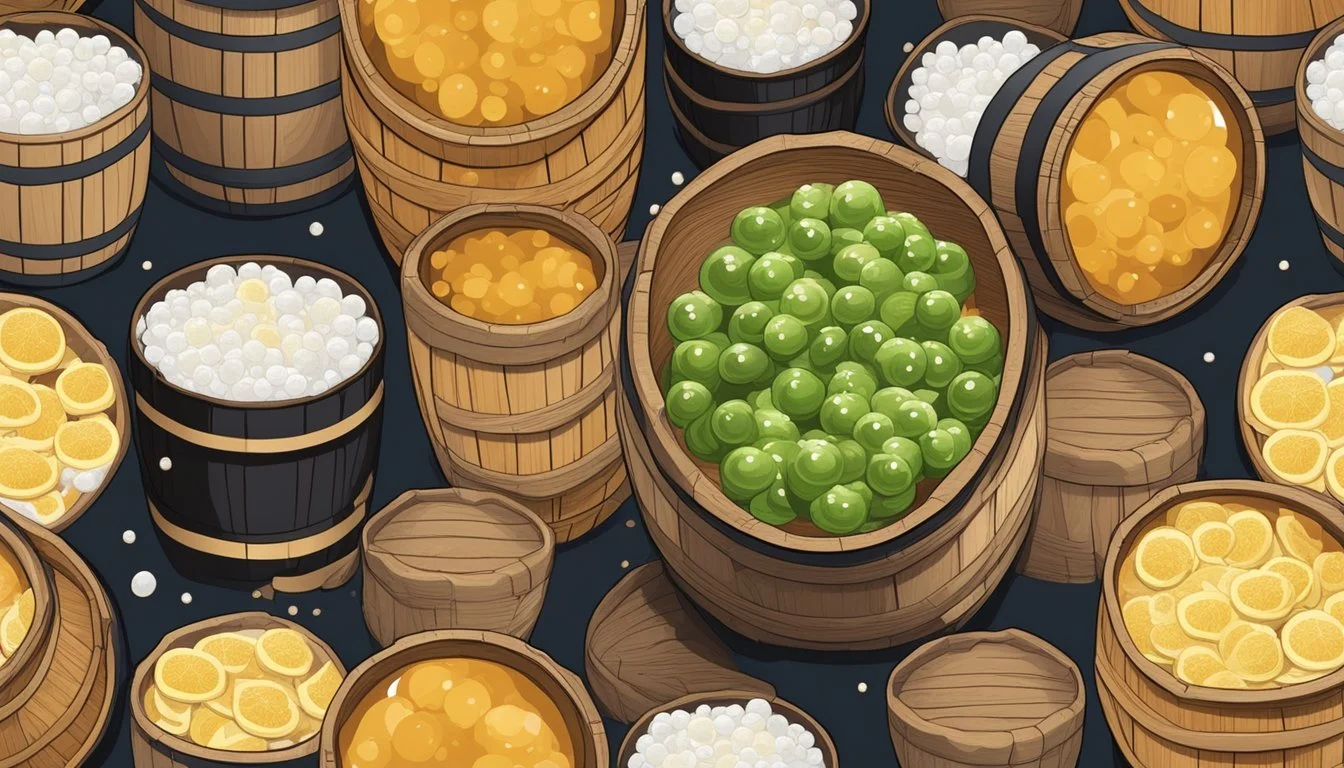10 Strangest Japanese Food
Unveiling the Most Unusual Culinary Delights
Japanese cuisine is renowned for its variety and depth, offering a plethora of dishes that range from sushi to ramen. While many are familiar with these popular options, there exists a fascinating array of lesser-known, unconventional foods that might surprise even the most adventurous eaters. Exploring these unusual culinary delights provides not only a deeper understanding of Japanese culture but also an exciting opportunity to expand one’s gastronomic horizons.
Cultural differences often make certain foods seem strange to outsiders, yet they hold significance and popularity within Japan. These unique dishes reflect the country's innovative approach to gastronomy and showcase the diversity of ingredients and preparation methods. By delving into the world of Japan's strangest foods, readers can gain a new appreciation for the rich and varied tapestry of Japanese cuisine.
1) Natto
Natto is a traditional Japanese dish made from fermented soybeans. It has a distinct and strong smell, often compared to ammonia or old cheese. The unique, slimy texture can be off-putting for newcomers.
Rich in protein, vitamins, and probiotics, natto is a nutritional powerhouse. It is often served with rice, soy sauce, and sometimes mustard.
Many Japanese people consume natto regularly, especially for breakfast. It is known for promoting gut health due to its high probiotic content.
Despite its challenging flavor profile, natto remains a beloved staple in Japan. Its taste is described as earthy, with a slight bitterness.
For those willing to try, natto offers a unique culinary experience, deeply rooted in Japanese culture. He or she might find the initial hesitation well worth the numerous health benefits.
2) Shirako
Shirako is one of Japan's most distinctive and unusual delicacies. This dish consists of the milt, or sperm sacs, of male fish, often cod or pufferfish. While the idea may seem unusual to some, in Japan, it's prized for its rich, creamy texture and delicate flavor.
Typically, shirako is served in a variety of ways. It can be enjoyed raw, lightly steamed, or deep-fried in tempura batter. Some restaurants also serve it in hot pot dishes, known as shirako nabe, where it is combined with vegetables and tofu.
In appearance, shirako is a white, slightly translucent substance that can sometimes be compared to the texture of soft custard. It's often described as having a mild, slightly sweet taste, with a hint of the sea.
The popularity of shirako extends beyond Japan. In other countries, similar dishes exist, such as "milt" in the United States and "moloka" in Russia. Despite its unconventional nature, those who are adventurous enough to try shirako often appreciate its unique texture and flavor. Many food enthusiasts consider it a delicacy worth trying.
3) Hachinoko
Hachinoko, or wasp larvae, is a unique culinary experience hailing from Japan's Nagano and Gifu prefectures. This unusual delicacy involves harvesting the larvae of wasps and preparing them in various traditional styles.
Hachinoko can be consumed in multiple ways. One common method is to sauté the larvae with soy sauce and sugar. This preparation offers a savory and slightly sweet flavor.
In some regions, hachinoko is available canned, making it a convenient snack. It's often highlighted on menus in local restaurants and holds cultural significance within the region.
Though it may seem odd to outsiders, hachinoko is cherished for its distinct taste and crunchy texture. Dining on these larvae is considered both an adventurous and traditional experience in Japan.
4) Fugu
Fugu, often known as pufferfish, is one of Japan's most infamous delicacies. This dish is renowned not only for its unique taste but also for the inherent risks involved in its preparation and consumption.
The fish contains tetrodotoxin, a potent neurotoxin that can be lethal if not properly prepared. Only licensed and highly trained chefs are allowed to handle and serve Fugu in Japan. These chefs undergo rigorous training to ensure the safe removal of toxic parts.
Fugu can be prepared in various ways, including sashimi, where the fish is sliced thinly and served raw. It is also cooked in hot pots (nabe) or deep-fried as tempura. Each method brings out different flavors and textures of the fish.
The taste of Fugu is often described as subtle and refined, with a slight chewiness. Despite its potential dangers, it remains a sought-after culinary experience for adventurous food enthusiasts visiting Japan. The thrill of consuming a potentially deadly meal adds to the allure and mystique of Fugu.
This dish exemplifies the high level of skill and precision in Japanese culinary arts, making it a truly unique dining experience.
5) Namako
Namako is the Japanese term for sea cucumber. It is a marine creature found in both shallow and deep sea environments.
Sea cucumbers have a gelatinous texture and a somewhat bland taste. They are often enjoyed for their unique mouthfeel.
In Japanese cuisine, namako can be served raw, pickled, or cooked. When served raw, it's called "namako sashimi."
Namako is appreciated for its potential health benefits. It is rich in nutrients such as protein, vitamins, and minerals.
Eating namako is believed to support joint health and improve skin condition, attributes treasured in traditional Japanese medicine.
Despite its unusual appearance, many people find its subtle flavor quite enjoyable. Namako is a delicacy that adventurous eaters may want to try.
Its preparation and presentation often highlight skilled culinary techniques found in Japanese cooking.
6) Tamago Kake Gohan
Tamago Kake Gohan, often abbreviated as TKG, is a popular Japanese breakfast dish featuring a raw egg served over steaming hot rice. This simple yet flavorful meal combines cooked Japanese short-grain rice with a raw egg cracked directly onto it.
The preparation begins with placing the hot rice in a bowl and creating a small well in the center. The raw egg is carefully cracked into the well, and a small amount of soy sauce is drizzled on top for added taste. Some variations include the use of mirin, salt, MSG, or Hondashi to enhance the flavor profile.
Immediately after the egg is added, it is thoroughly mixed with the rice to create a creamy, smooth texture. The heat from the rice partially cooks the egg, creating a comforting yet distinct flavor. Due to its simplicity, the quality of the ingredients—especially the eggs and rice—is crucial.
Tamago Kake Gohan is appreciated for its ease of preparation and nutritional value, making it a staple in many Japanese households. Despite its simplicity, the dish's unique combination of textures and flavors has earned it a place among the most unusual yet beloved foods in Japan.
7) Milt
Milt, known as shirako in Japan, is the fluid-filled sperm sac of a fish. This unusual delicacy astounds many, encompassing a uniquely creamy texture and a smooth, slightly sweet flavor. Popular fish sources for milt include cod, anglerfish, and pufferfish.
Shirako is often served in various ways. It can be enjoyed raw as sashimi or sushi. Some prefer it lightly cooked in dishes like tempura or added to hot pots.
Usually, shirako is a winter specialty, known for its rich taste and nutritional value. Nutrient-wise, it's packed with protein and considered aphrodisiac by some. Despite its peculiar nature, it has a dedicated following among locals and adventurous tourists.
Many restaurants across Japan feature shirako on their seasonal menus, particularly in izakayas and upscale sushi establishments. The preparation and presentation are key, often highlighting its delicate texture and subtly salty flavor.
8) Funazushi
Funazushi is a traditional Japanese dish that involves fermenting fish in rice. This delicacy originates from Shiga Prefecture and uses freshwater fish from Lake Biwa, typically a species called funa.
The preparation process is meticulous. The fish are cleaned and salted before being packed in rice. This allows them to ferment for several months, sometimes even up to a year.
The resulting flavor is intensely pungent and sour. The texture is soft, and the aroma can be quite strong. This makes Funazushi an acquired taste, appreciated by those who enjoy strong and unique flavors.
Despite its challenging taste, Funazushi holds cultural significance. It is often consumed during special occasions and festive gatherings, such as New Year's Day or weddings.
Only a few places in Japan specialize in authentic Funazushi. These establishments are frequently family-owned and have been perfecting their recipes for generations. Their dedication ensures that each bite of Funazushi is a true representation of this historical delicacy.
Some people compare the taste of Funazushi to strong blue cheese due to its overwhelming and distinct flavor. Though not for everyone, adventurous eaters might find it a compelling addition to their culinary experiences.
9) Kujira
Kujira refers to whale meat, which has been a part of Japanese cuisine for centuries. Historically, it was a significant source of protein in the Japanese diet, especially after World War II.
Whale meat can be prepared in various ways, including sashimi, where it’s served raw, or cooked in dishes like curry and stews. Some traditional methods involve marinating the meat with soy sauce and ginger.
The texture of kujira is often described as firm and slightly chewy. It possesses a rich, gamey flavor, somewhat similar to that of red meat. In modern times, kujira is considered a delicacy and is less commonly consumed due to changing attitudes and international restrictions on whaling.
Despite its reduced presence on the dining tables, kujira remains an intriguing part of Japan's culinary heritage. Some local markets and specialty restaurants still offer it, catering mainly to adventurous foodies and those interested in traditional flavors.
10) Yakitori Cartilage
Yakitori cartilage, known as nankotsu, is a traditional Japanese dish featuring chicken cartilage. This dish usually utilizes the cartilage from the breast bone or the leg.
Nankotsu is typically served on skewers and grilled, aligning with the yakitori style of preparation. The dish can also be deep-fried, offering a different texture and flavor profile.
The appeal of nankotsu lies in its unique texture, which is both crunchy and chewy. This makes it a popular choice for those seeking a different type of eating experience.
Flavor-wise, nankotsu is quite mild, allowing the method of preparation and accompanying sauces to shine. Often, it is served with a bit of lemon for added zest.
In addition to its unique taste and texture, eating cartilage is said to be beneficial for the skin and hair. This makes it a favored dish beyond just its novelty.
Cultural Significance of Japanese Cuisine
Japanese cuisine is a blend of tradition and modernity, profoundly influenced by its historical roots and adapted to contemporary tastes. The intricate preparation and presentation reflect the nation's cultural values.
Historical Background
Japan's culinary traditions date back centuries, shaped by geography, climate, and societal changes. Early influences from China and Korea introduced rice cultivation and the use of chopsticks. The introduction of Buddhism in the 6th century led to a vegetarian diet, emphasizing seasonal vegetables and tofu. During the Edo period (1603-1868), sushi and tempura became popular street foods. The Meiji Restoration (1868) brought Western influences, integrating meat and dairy products into the Japanese diet, dramatically changing eating habits and techniques.
Modern Interpretations
Contemporary Japanese cuisine blends tradition with innovation. While sushi, ramen, and tempura remain popular, chefs experiment with fusion recipes, combining Western and Asian elements. Unique and unusual dishes, such as nankotsu and umi budo, cater to adventurous palates. Additionally, Japan has embraced global food trends, resulting in a diverse culinary landscape that continues to evolve. The rise of Japanese cuisine's global popularity is evident with UNESCO recognizing it as an Intangible Cultural Heritage, celebrating its importance beyond Japan’s borders.
Health Benefits and Controversies
Many strange Japanese foods offer unique nutritional benefits, yet some are subject to misconceptions and controversies that affect their consumption. This section explores the nutritional aspects and clarifies common misunderstandings about these unique dishes.
Nutritional Value
Strange Japanese foods often provide notable nutritional benefits. For example, natto, which is made from fermented soybeans, is rich in protein, vitamins, and probiotics. These nutrients support digestive health and boost the immune system.
Basashi, or horse meat sashimi, is another nutrient-dense option. It is low in fat and high in protein and iron. The omega-3 fatty acids found in certain seafood dishes, such as umi budo (sea grapes) and fugu (pufferfish), are beneficial for heart health.
Shirako (cod sperm), despite its unusual nature, contains high levels of omega-3 fatty acids and protein. These contribute positively to cardiovascular health and muscle maintenance.
Foods like sea cucumbers and specific types of jellyfish are valued for their collagen content, which benefits skin health and joint function. Despite their unique appearance, these foods provide essential vitamins and minerals.
Common Misconceptions
Several strange Japanese foods are often misunderstood. For instance, natto is sometimes dismissed due to its slimy texture and strong smell, but it is actually highly nutritious and beneficial for digestive health.
There are safety myths surrounding fugu. While it is true that this pufferfish can be toxic if not prepared correctly, licensed chefs in Japan undergo extensive training to ensure its safe consumption.
Some people view basashi (horse meat) as unconventional or unsafe. However, in Japan, it is regarded as a delicacy and is consumed raw, similar to sushi, without adverse health effects when prepared properly.
The consumption of shirako can evoke discomfort due to its origin, yet it is respected in Japanese cuisine for its delicate flavor and health benefits. Addressing these misconceptions helps in appreciating the nutritional value of these intriguing foods.









